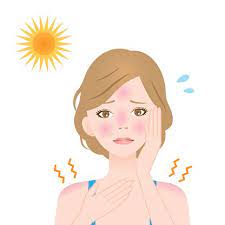Sunburn occurs when the skin gets burned due to excessive exposure to sunlight. It is an inflammatory response triggered by ultraviolet (UV) radiation, which harms the outermost layers of the skin. Symptoms usually appear within a few hours of exposure. The pigment melanin helps protect the skin from UV rays by darkening unprotected areas. Since melanin production is genetically determined, some individuals tan while others burn.
Types of Sunburn:
- First-degree sunburns
- Second-degree sunburns
- Deep partial-thickness second-degree burns
Symptoms of Sunburn:
Redness or pink discolouration on the affected area
Swelling
Warm or hot sensation on the skin
Small, fluid-filled blisters
Gritty or painful eyes
Flaky skin or red spots
Severe cases may include fever, headache, nausea, and fatigue (commonly referred to as sun poisoning)
Itchy, dry, and peeling skin 4-8 days after the burn
Duration of Sunburn:
- Mild sunburn: Symptoms persist for about 2-3 days
- Moderate sunburn: Symptoms last around 5 days
- Severe sunburn: May last more than a week
Since UV rays harm the skin, the immune system works to repair the damage. The body's immune response is primarily restored during sleep, which is why sunburn may cause drowsiness. Any exposed body part, including earlobes, lips, and the scalp, can be affected. Eyes are especially sensitive to UV rays and can suffer damage as well.
Causes of Sunburn:
Sunburn is caused by exposure to UVA, UVB, and UVC radiation. People with lighter skin tones are more prone to sunburn than those with darker skin. Any time the skin is unprotected by clothing or sunscreen and is exposed to excessive sunlight, it may burn or tan. Even if the skin does not visibly tan or burn, sun exposure can still cause long-term damage, leading to wrinkles and an increased risk of skin cancer.
When to See a Doctor?
Seek medical attention if sunburn:
- Covers a large portion of the body.
- It is accompanied by blisters, severe pain, or high fever.
- Causes dehydration, loss of consciousness, headache, nausea, or chills.
How do UV Rays Affect the Skin?
Both UVA and UVB rays contribute significantly to sunburn. UVB rays increase chemokine production and activate peripheral nociceptors, leading to an over-activation of pain receptors in the skin. On the other hand, UVA rays primarily cause direct DNA damage, which can lead to long-term skin issues.
Preventive Measures for Sunburn:
Avoid sun exposure between 10 AM and 4 PM.
Apply sunscreen at least 15-30 minutes before going outdoors.
Wear a wide-brimmed hat.
Cover your skin with long sleeves and full-length pants.
Use sunglasses that block UV rays.
Seek shade or use an umbrella.
To minimize the risk, cover as much skin as possible and opt for a high-SPF sunscreen, especially in island or tropical regions.
Sunburn Treatment and Management:
Apply a moisturizer containing aloe vera to soothe the skin.
Stay hydrated by drinking at least 3-4 litres of water daily.
Drink coconut water to replenish electrolytes.
Avoid scratching or breaking blisters.
Limit further sun exposure.
Consider using anti-itch medications prescribed by a doctor.
By following these precautions and remedies, you can reduce discomfort and prevent further skin damage.
|

